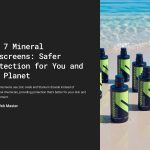 With growing awareness of skincare and environmental impact, the demand for mineral-based sunscreens without harmful ingredients is rising rapidly. Unlike chemical sunscreens that often contain controversial compounds like oxybenzone or octinoxate, mineral sunscreens use naturally occurring ingredients such as zinc oxide and titanium dioxide to provide broad-spectrum UV protection. Consumers are now prioritizing clean formulations that not only protect their skin but also preserve coral reefs and ecosystems. In this post, we dive into the best safe and non-toxic sunscreens of 2025 that are gentle, effective, and suitable for all skin types—even for babies and sensitive skin. These selections reflect both the newest dermatological recommendations and eco-conscious trends.
With growing awareness of skincare and environmental impact, the demand for mineral-based sunscreens without harmful ingredients is rising rapidly. Unlike chemical sunscreens that often contain controversial compounds like oxybenzone or octinoxate, mineral sunscreens use naturally occurring ingredients such as zinc oxide and titanium dioxide to provide broad-spectrum UV protection. Consumers are now prioritizing clean formulations that not only protect their skin but also preserve coral reefs and ecosystems. In this post, we dive into the best safe and non-toxic sunscreens of 2025 that are gentle, effective, and suitable for all skin types—even for babies and sensitive skin. These selections reflect both the newest dermatological recommendations and eco-conscious trends.

Why You Should Avoid Harmful Ingredients in Sunscreens
Many conventional sunscreens include chemical UV filters that may cause skin irritation, disrupt hormones, and harm marine life. Ingredients like oxybenzone, avobenzone, homosalate, and octinoxate have come under scrutiny by researchers and environmental groups. For example, Hawaii has banned the sale of sunscreens containing certain ingredients due to their link to coral reef bleaching. In addition to environmental impact, some of these chemicals are easily absorbed into the bloodstream and may linger in the body for days.
Switching to mineral sunscreens helps eliminate exposure to these questionable ingredients. Mineral-based options create a physical barrier on the skin that reflects UV rays rather than absorbing them. They are often recommended by dermatologists for children, pregnant women, and people with sensitive or allergy-prone skin. Today, many brands have developed formulas that are non-greasy, easily blendable, and lightweight—completely changing the outdated perception of mineral sunscreens being chalky or thick.

Best 7 Non-Toxic Mineral Sunscreens in 2025
After reviewing dermatologist recommendations, user reviews, and ingredient safety data, here are the top-rated mineral sunscreens without harmful ingredients:
- Thinkbaby Safe Sunscreen SPF 50+ – Pediatrician-recommended and reef-safe.
- Badger Active Mineral Sunscreen Cream SPF 30 – USDA-certified organic with only five ingredients.
- Blue Lizard Sensitive Mineral Sunscreen SPF 50+ – Loved by dermatologists for sensitive skin.
- Babo Botanicals Clear Zinc Sunscreen SPF 30 – Lightweight and non-whitening.
- ATTITUDE Mineral Sunscreen SPF 30 – Fragrance-free and EWG-verified.
- Earth Mama Baby Mineral Sunscreen SPF 40 – Gentle enough for newborns.
- Juice Beauty SPF 30 Sport Sunscreen – Antioxidant-rich and water-resistant.
These sunscreens are formulated without parabens, phthalates, synthetic fragrances, PEGs, and harsh preservatives. Many are cruelty-free, vegan, and packaged in eco-friendly containers.

How to Identify Truly Safe Sunscreen Labels
Reading labels is essential. Look for:
- Active ingredients: Only zinc oxide or titanium dioxide
- Certifications like EWG Verified, NSF/ANSI 305, or USDA Organic
- Avoid: “Fragrance,” “Parfum,” “Oxybenzone,” “Retinyl Palmitate”, or long chemical lists
- Water resistance labeling (40 or 80 minutes) if needed for swimming
Brands often use “reef-safe” or “clean” as marketing terms, but they aren’t regulated. Verify claims by checking third-party certifications or resources like EWG’s database. Also, minimalist formulas (5–10 ingredients) tend to be safer and less irritating.

Benefits of Switching to Mineral Sunscreens
There are multiple long-term benefits:
- Health: Reduce exposure to endocrine-disrupting chemicals
- Environment: Prevent coral reef bleaching and water contamination
- Skin comfort: No stinging, burning, or allergic reactions
- Longevity: Zinc oxide provides longer-lasting protection on skin
Modern mineral sunscreens have overcome the historic challenges of heavy textures. They now come in tinted versions for a smoother finish, or infused with plant extracts like green tea and aloe for soothing effects.

Ideal Sunscreen Routine for All Skin Types
Here’s how to build a simple and effective sun protection habit:
- Daily use: Apply even on cloudy days and indoors
- Amount: Use a nickel-sized amount for the face, a shot-glass for the body
- Timing: Apply 15 minutes before sun exposure
- Reapplication: Every 2 hours or immediately after sweating or swimming
For acne-prone skin, opt for non-comedogenic and fragrance-free mineral sunscreens. Dry skin types may benefit from formulas with added moisturizers like squalane or shea butter.

FAQs: Mineral Sunscreen Misconceptions
Q: Does mineral sunscreen leave a white cast?
A: Modern formulas with micronized zinc oxide offer near-invisible finishes. Some brands also offer tinted versions.
Q: Is mineral sunscreen safe for babies and pregnancy?
A: Yes, it’s the safest type for infants and expecting mothers due to the minimal absorption of ingredients.
Q: Are higher SPFs better?
A: SPF 30 blocks about 97% of UVB rays. Higher SPFs offer slightly more protection but not significantly, and reapplication is key.
Q: Can mineral sunscreen cause breakouts?
A: Not usually. In fact, zinc oxide has anti-inflammatory properties and can help soothe acne-prone skin when paired with a clean base form
*Capturing unauthorized images is prohibited*


